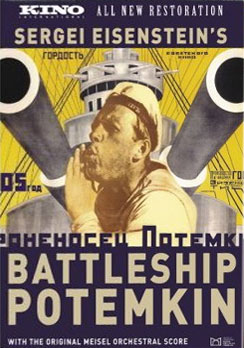 “Battleship Potemkin†is a dynamic achievement, a film that represents the primitive greatness of the silent era. Audiences were electrified when it opened in 1925: They’d seen the famous disguises of Lon Chaney and the comic peril of Buster Keaton, but this was different. They weren’t responding to the performances – they were aroused by great movie-making that helped establish film as art. (MGM producer David O. Selznick urged colleagues to “view it in the same way that a group of artists might study a Rubens or a Raphael.â€) Different prints range from watchable to embarrassing, but Kino’s new DVD restoration is the first one to get it right.
“Battleship Potemkin†is a dynamic achievement, a film that represents the primitive greatness of the silent era. Audiences were electrified when it opened in 1925: They’d seen the famous disguises of Lon Chaney and the comic peril of Buster Keaton, but this was different. They weren’t responding to the performances – they were aroused by great movie-making that helped establish film as art. (MGM producer David O. Selznick urged colleagues to “view it in the same way that a group of artists might study a Rubens or a Raphael.â€) Different prints range from watchable to embarrassing, but Kino’s new DVD restoration is the first one to get it right.
When I compared Kino’s DVD with a copy from Delta Entertainment, the results were devastating: Countless details have been restored, including reinserted title cards and the magnificent soundtrack. (Edmund Meisel’s score adds a pounding rhythm to the excitement.) Footage that was trimmed out has been returned, giving director Sergei Eisenstein’s montages the delirium they were conceived with.
Eisenstein’s film celebrates the Russian uprising against czarism in 1905, beginning with a piece of meat swarming with maggots – it conjures mutiny on a ship of hungry men. More than 50 shots, including the famous close up of squirming maggots, were omitted in 1926. (The restored version is offered here.) Despite its abuse, “Leonard Maltin’s Movie Guide†gave “Potemkin†a four-star rating: “Unlike many staples of film history classes, this one has the power to grip any audience. Odessa Steps sequence is possibly the most famous movie scene of all time.â€
The Odessa Steps sequence. That’s the scene where troops open fire on innocent citizens. The shot of the orphaned baby carriage bouncing down the steps is one of the most fundamental images in the history of cinema: Brian De Palma sampled it for “The Untouchables,†Woody Allen spoofed it in “Bananas.†A list of movie connections on the Internet Movie Database (www.imdb.com) includes “Foreign Correspondent,†“Bonnie and Clyde,†“The Way We Were,†“Beauty and the Beast,†“28 Weeks Later†and many others. When we watch quick-cutting montages in other films, we’re looking at responses to this one – it’s almost impossible to see “Potemkin†without hearing the echoes of its imitators.
Look for Kino’s high-def transfer of F.W. Murnau’s “Nosferatu,†also on DVD: The Murnau film is another landmark of silent cinema, but Eisenstein’s film stands above the others. In a 1998 review, Roger Ebert mentioned that “it was voted the greatest film of all time at the Brussels World’s Fair in 1958.†That wouldn’t have made much sense to Eisenstein – he insisted that the greatest movie ever made was “Snow White and the Seven Dwarfs.â€

Leave a Reply